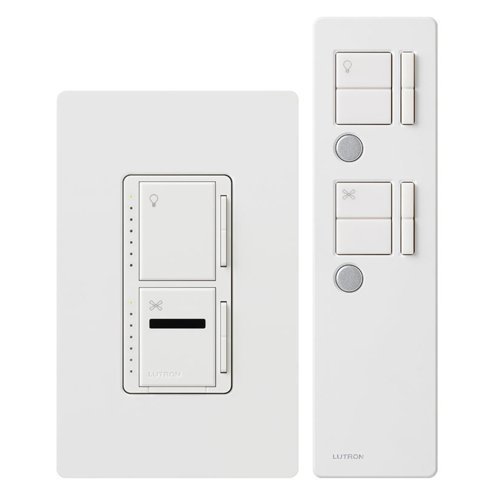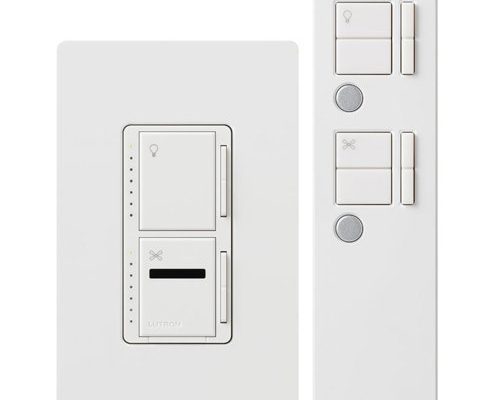
Here’s where things get interesting. The Lutron ceiling fan remote (like their popular Caséta Fan Control) isn’t your average click-and-go device. It’s more like a universal translator, but only if the other fan “speaks” the same language. If you’re wondering whether a Lutron remote will work with Hunter, Hampton Bay, or another brand, let’s break it down together. No jargon, just real talk about what works, what doesn’t, and what you need to know before you start mixing and matching.
How Lutron Ceiling Fan Remotes Really Work
Before we get lost in a sea of brands and model numbers, let me explain how the Lutron ceiling fan remote actually talks to your fan. Lutron doesn’t just make simple IR (infrared) remotes like you’d find for your old TV. Instead, their fan remotes—especially the Caséta line—use wireless RF (radio frequency) signals and sometimes even leverage smart home protocols like Clear Connect.
Why does that matter? Because *compatibility* comes down to the kind of “language” your fan and the remote use. Most ceiling fan remotes (the ones tucked in the packaging or sold as replacements) use their own manufacturer’s RF code—think of it as their secret handshake. Lutron’s system is designed to *pair* with its own Lutron smart fan controller, not third-party receivers.
Honestly, it’s like expecting a PlayStation controller to magically control an Xbox. The tech inside just isn’t built for it—unless the fans are specifically designed to play nice with Lutron.
If your ceiling fan has a Lutron-compatible smart receiver wired in, then you’re golden. But a standard Hunter, Hampton Bay, or Harbor Breeze receiver? That’s a different story.
Pairing and Syncing: Why Most Fans Aren’t Plug-and-Play
You might be wondering, “Can’t I just hit a sync button or enter some code and make it work?” Here’s the thing: most ceiling fans come with a receiver (the bit inside the fan that listens to the remote) made for their own remote. The Lutron remote, meanwhile, is built to *pair* with the Lutron fan speed control switch—the actual hardware you wire into the wall to operate your fan.
So, swapping remotes isn’t as simple as swapping batteries or pressing reset. Even if both remotes are “RF,” their frequencies and codes are usually different. If your existing fan uses a standard remote, and you try to pair the Lutron remote with it, the signals just won’t line up. The fan won’t know what you’re saying.
Here’s a typical setup:
- The original fan remote is pre-programmed to its receiver.
- Lutron’s remote is meant for a Lutron-installed controller/switch, not the default receiver found in different brands.
- There’s no “universal sync” function between these two systems.
Bottom line? No amount of code entry or pairing tricks will make a Lutron ceiling fan remote work with another brand *unless* you’ve installed a Lutron controller.
Lutron Caséta Fan Control: What It Can (and Can’t) Do
Let’s focus on the Lutron Caséta Fan Control, since that’s what most folks are searching for when they want to control their fans wirelessly or through smart home tech. The Caséta system lets you adjust fan speed, sync it with schedules, and even control it with your phone or voice assistant—if, and only if, your fan is wired to the specific Caséta Fan Control switch or module.
You’ll need to:
- Replace your old wall switch with the Caséta Fan Control switch (which requires basic wiring skills).
- Use the Lutron Pico remote (designed for Caséta products) to control the fan through the new switch.
- Sync the Pico to the Caséta switch—no codes, just a simple pairing process.
Think of the Pico as a “remote for the switch,” not a direct remote for the fan. If your ceiling fan is powered only by pull chains, or only uses the original brand remote, a Lutron remote won’t do a thing unless you install the matching Caséta switch or smart module. Also, the Caséta Fan Control is designed for fans *without* built-in lights (or at least, it won’t control the light part).
Here’s a quick story: my neighbor tried wiring a Caséta switch to an old Westinghouse fan, hoping the Lutron Pico would let her ditch the janky original remote. But when she left the fan’s original receiver inside, nothing happened. It finally worked only after bypassing the old receiver and wiring the fan *directly* to the Caséta switch.
Why Lutron Remotes Aren’t “Universal” For Ceiling Fans
If you search “universal ceiling fan remote,” you’ll find a dozen gadgets promising to control anything under your roof. Lutron’s remotes, on the other hand, are picky about who they talk to. The whole system’s logic is different. Instead of being a plug-and-play replacement, it’s a high-end solution meant to integrate with the rest of your smart lighting and home automation.
Here’s what makes Lutron “not universal” for most other brands:
- Custom Codes and Frequencies: Lutron uses proprietary RF protocols. Most fan brands (Hunter, Hampton Bay, Harbor Breeze, etc.) use completely different frequencies and pairing codes.
- Hardware Dependency: The Lutron Pico remote only works with a Lutron switch or controller—not the receiver built into your regular store-bought fan.
- No Direct Syncing: There’s no “learning” or universal sync function. If you want a remote that works with multiple brands, you need a separate universal kit meant for that purpose.
Let me be clear: unless your ceiling fan is wired to Lutron’s smart controller, you can’t pair the Lutron Pico remote—or any Lutron fan remote—directly to your existing fan receiver. The remote isn’t magic; it’s just highly specific.
Common Problems and Troubleshooting: When It Still Doesn’t Work
Tried everything and still can’t get your Lutron ceiling fan remote working with another brand? Don’t worry, you’re not alone. Here are the usual issues and what they really mean:
- No Response: If the fan ignores the Lutron remote, it’s likely because the fan’s receiver doesn’t understand Lutron’s RF code. They’re just not compatible.
- Sync Fails: Holding “pair” or “reset” on the Lutron remote won’t do anything unless a Lutron switch or controller is wired in.
- Wrong Wiring: If you try to use the Lutron wall switch with an existing fan receiver, nothing will sync. You must bypass the old receiver entirely—this sometimes requires re-wiring, so be careful or call an electrician.
- Battery Issues: If your Pico remote’s battery is dead, nothing will work. Always check the battery first—it saves headaches!
If you’re stuck, walk through these steps:
- Check that your fan is *wired directly* to the Caséta Fan Control, not the original receiver.
- Pair the Pico remote with the Caséta switch (follow Lutron’s instructions—usually a button press on the switch).
- If it still doesn’t work, double-check wiring or consult a pro. Sometimes the wiring inside older fans can make things tricky.
Let me explain: it’s easy to assume a fancy smart remote will work on anything with blades, but Lutron’s system is more like a club—you need the membership card (the switch) to get in.
Lutron vs. Universal Ceiling Fan Remotes: What’s the Difference?
Here’s a common mistake: people confuse Lutron’s smart fan controls with true universal remotes. Universal ceiling fan remotes are designed to replace almost any original remote, usually by swapping out the receiver inside your fan with their own. These kits typically include:
- A new receiver (the part you wire into the fan’s canopy)
- A remote (usually with generic RF frequency options and a basic pairing system)
These universal kits work because they replace both the remote *and* the part of the fan that listens for commands. Lutron’s system, meanwhile, is all about integrating with their smart home products—think smart smartphones, Alexa, Google Home, etc. It’s less about “universality” and more about “ecosystem.”
Which is better? If you want smart controls, schedules, and app control, Lutron is hard to beat—but only if you’re willing to install the matching hardware. If you just want to replace a lost or broken remote for a fan from another brand, a universal kit (not Lutron) is usually your answer.
Best Use Cases for Lutron Fan Remotes and Smart Controls
So, when does a Lutron ceiling fan remote make sense? Let’s paint a picture. You’re building out a smart home with automated lights, shades, and scenes. You want your ceiling fans on a schedule, or you’d love to be able to change the speed with your voice. In these cases, swapping in a Lutron Caséta Fan Control switch—and using the Pico remote—is a solid move.
But let’s say you just want to control a random fan in your guest room, or you’re not interested in wiring up anything new. Lutron probably isn’t the right fit—at least not without swapping out the hardware inside your wall.
Here’s when Lutron shines:
- You already use Lutron Caséta for lights or shades.
- You want to control multiple ceiling fans as part of smart scenes or routines.
- You’re comfortable with basic electrical work (or you’ll hire someone who is).
- Your fan doesn’t need an integrated light controlled from the same switch (since Lutron’s current Caséta Fan switch is fan-only).
If you fit this picture, the investment pays off with reliability and integration. Otherwise, look for a remote or kit made for your specific fan brand.
Alternatives for Controlling Other Brands of Ceiling Fans
Not ready to rewire your whole house for Lutron? That’s perfectly understandable. There are other ways to get remote control of your ceiling fan, even if it’s not a Lutron. Some options include:
- Universal Remote Kits: These include a new receiver and remote, and they’re made specifically to work with a wide range of fan brands.
- Brand-Specific Replacements: Order a replacement remote directly from the fan’s manufacturer—just match the model and code.
- Smart Fan Modules: Some fans (like those from Bond, HomeKit, or specific IoT brands) can add Wi-Fi or Bluetooth modules for app-based control, no new switches needed.
Here’s an insight: the best option depends on whether you want “set it and forget it” smart control, or just a cheap, quick fix for a lost remote.
Of course, if you ever change your mind, you can always upgrade to Lutron’s system later—but just know it won’t play nice with your old remotes or receivers.
Final Thoughts: Should You Try Mixing Lutron Remotes With Other Ceiling Fan Brands?
Trying to control a non-Lutron ceiling fan with a Lutron remote is like trying to use a car key on your neighbor’s Tesla. Without the right receiver or controller installed, nothing’s going to happen. Lutron remotes are incredible—for Lutron-controlled fans. They’re just not designed to be a universal fix for fans from other brands.
If you’re building out a smart home and ready to do some wiring, Lutron’s fan controls are smart, reliable, and perfect for routines and automation. If you’re just looking to replace a lost remote for an older ceiling fan, stick to universal kits or brand-specific replacements.
At the end of the day, matching remotes and fans is all about compatibility—not just brand names, but the guts inside the wall and inside the fan canopy. Take your time, check what you’ve got, and you’ll find the right control for your fan setup—Lutron or otherwise.
